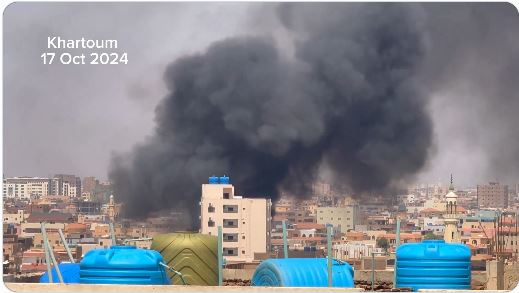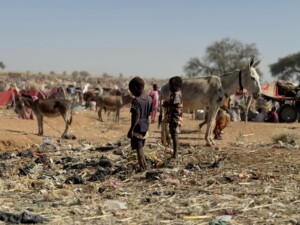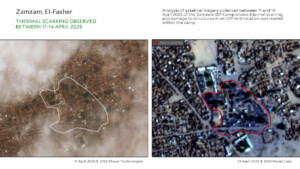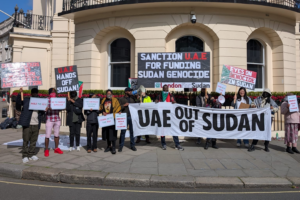RSF deploys snipers in central Khartoum as Sudan air force continues bombing

Still from footage of an airstrike on the El Firdaws neighbourhood in southern Khartoum in mid-October (Video: journalist Migdad Hasan via X)
The Sudanese Armed Forces (SAF) yesterday continued its attempts to regain central Khartoum, including the army’s General Command, from the paramilitary Rapid Support Forces (RSF). In West Darfur, fierce fighting took place between RSF soldiers and the Joint Force of rebel fighters. The army’s progress on the ground cannot directly be linked to the intensification of airstrikes. Residents of El Geneina reported ‘hearing new warplanes’.
Three weeks ago, the SAF, aided by various armed groups, launched a major ground offensive, supported by artillery and airstrikes,on key areas in Khartoum and Khartoum North/Bahri, occupied by the RSF since the start of the war in mid-April last year.
Radio Dabanga reported on Tuesday that the SAF maintained its positions retaken from the RSF in El Mogran (where the two Niles meet), while fighting continued in other areas in the capital. An army officer said that they aim to advance east towards the General Command, after they have chased all paramilitaries from the area.
Yesterday, fierce ground fighting, accompanied by SAF air raids on RSF sites, was reported from central and southern Khartoum. A source told Radio Dabanga from the city that “sounds of explosions and heavy shooting” were heard in various areas in northwest Khartoum.
The RSF deployed snipers in central Khartoum, which hindered the army’s advance into central Khartoum, he said, and added that southern Khartoum “witnessed fighting between forces in armoured vehicles and armoured personnel carriers”.
The source further reported continuing battles in Khartoum Bahri. “The first displaced are returning to their homes in Halfaya, Azergab, Doroshab, and Kadaro after the army took control of these areas.”
He said that the SAF now attempts to invade RSF-controlled Shambat in southwest Khartoum North, while continuing to bomb RSF positions in the area with airstrikes.
Radio Dabanga has contacted the army and the RSF for comments, but did not receive a response.
Darfur rebel combatants
Yesterday also witnessed battles in Jebel Awum in West Darfur between the RSF and combatants of the Joint Force of Armed Struggle Movements, aka Sudanese Joint Force(s)* fighting alongside the army.
On September 30, the Joint Force claimed control over Awum, which lies between the towns of Kulbus and Selea along the border with Chad. In response, the RSF deployed large groups of its paramilitaries in the vicinity.
“The fighting broke out this morning at dawn, when the RSF attacked the joint force in Jebel Awum from two directions,” a listener reported.
The Sudanese Joint Force had also taken control of areas in Kulbus (north of Jebel Awum) and Sirba (south of the area) before withdrawing from them.
Maj Ahmed Hussein, spokesperson for Sudanese Justice and Equality Movement (S-JEM) headed by Finance minister Jibril ibrahim** and the Sudanese Joint Force, announced that “we were able to close the only outlet that supplies the RSF with logistical and military supplies, after having achieved victories in West Darfur, especially Jebel Awum, Kulbus, and Sirba”.
Offensive
After a lull that lasted for more than two months, ground battles between the warring parties returned after the army launched offensives on three main fronts.
On September 26, SAF soldiers and allied militias entered Khartoum North/Bahri via the Halfaya Bridge. A retired army officer told Radio Dabanga on Wednesday that “this operation allowed the SAF to deliver supplies to its forces in the Hattab military base previously besieged by the RSF forces, but they did not succeed in advancing south towards the old Bahri neighbourhoods and lifting the siege on the Signal Corps base [in the south of the city].
The SAF was also unable to force the RSF stationed at the El Jeili Oil Refinery north of Khartoum to abandon their positions, he said.
Army soldiers also succeeded in crossing the old Iron Bridge from Omdurman and positioning themselves at its entrance at the Khartoum side. “However, it failed to advance eastward across Nile Street towards the Republican Palace or even fully control the main towers in that area,” the military source said.
Simultaneously, SAF units in southern Omdurman sought to cross the El Fitihab Bridge, but were forced to retreat because of resistance by RSF paramilitaries firing from the Sunut (Acacia) Forest and El Mogran. “This was primarily related to the RSF heavy deployment of snipers in high buildings and towers in El Mogran. The Sudanese Air force refrained from bombing the RSF as the use of warplanes in this small area would cause heavy losses among the army forces that were trying to advance in the area.”
According to video clips published by army loyalists, the SAFwas able to control the Zain Tower, the El Shaheed Mosque, and the Electricity and Water Corporation in El Mogran since the beginning of this week, while the RSF are stationed in the Central Bank of Sudan and the Sahel and Sahara Tower.
In southwest Khartoum, the Armoured Corps reported on Wednesday that it was able to control the entire El Lamab area in the vicinity, along the White Nile. “Our forces are moving steadily towards the rest of the sites and targets and are preparing for decisive battles with the enemy in Khartoum.”
The third front is the Sennar-Kosti axis, where the SAF on October 5 succeeded to regain control of Jebel Moya in western El Gedaref. “This is a very important strategic area,” the military expert explained. “Recapturing Jebel Moya allowed the reopening of the Sennar-Rabak road and the delivery of supplies to the forces stationed at the Kenana Air Base, the 18th Infantry Division in Kosti, and the El Sayyad battalion in Tandalti (Tendelti) in the south of North Kordofan.”
Intensified air raids
The recent balance of power returning to the army on the ground can be linked to the intensification of air strikes, “both in quantity and quality”, on areas controlled by the RSF. This coincides with information claiming that the Sudanese army obtained new fighter jets with funding from several countries supporting the army.
RSF Commander Mohamed ‘Hemeti’ Dagalo confirmed the decisive role of the Sudanese Air Force in his impromptu speech last week, in which he accused the Egyptian Air Force of interfering in the war in Sudan and held it responsible for the losses his paramilitary forces suffered in the battle for Jebel Moya.
During his return to the Wadi Sidna (Sayedna) Air Base in northern Omdurman after having visited Jebel Moya, SAF Commander Lt Gen Abdelfattah El Burhan said that the air force played a major role in regaining control of several areas, most notably Jebel Moya.
On October 5, the Sudanese Air Force bombed the market of El Koma, located 76 kilometres east of the North Darfur capital of El Fasher. Dozens of people were killed.
The area of Selea, near Jebel Awum, in West Darfur, was bombarded the following day, the. The number of victims could not be determined because of communications outages throughout the area.
Six days later, on October 12, more than 20 people were killed in airstrikes on neighbourhoods and the El Soug El Markazi in southern Khartoum.
On the afternoon of October 13, warplanes launched airstrikes on the town of Abu Hajar, east of Singa in Sennar, killing and wounding dozens.
The most violent aerial bombardments launched by the Sudanese Air Force recently were the ones that hit Nyala, the capital of South Darfur, on Monday evening, October 14. A warplane flew over the city for more than 55 minutes, during which it dropped about eight bombs on the neighbourhoods near the airport. These airstrikes coincided with reports of unidentified aircraft landing at the airport.
On October 13 and 14, warplanes bombed RSF positions in the eastern and southern parts of El Fasher.
The following day, El Geneina, the capital of West Darfur, witnessed several aerial attacks on the city’s neighbourhoods and airport. The aeroplane that dropped the bombs appeared to be “a more modern model,” Alaaeldin Babiker, a journalist residing in El Geneina, told Radio Dabanga. He noted the “low sound of its engine and its high altitude compared to previous aircraft” of the Sudanese Air Force.
Drones, artillery
In the face of the army’s superiority in the air, the RSF seeks to use suicide drones to cover up its lack of air combat capabilities. On October 6, the paramilitary group attempted to attack the Kenana Air Base in White Nile state with three drones.
The military expert considers the effectiveness of the RSF drones “questionable” as “they will not be able to cause any significant losses to the army or facilities in the areas under its control”. He attributes this to “the primitive nature of these drones, which makes them easy to detect, as well as the limited capacity of their warheads, which reduces their destructive capacity.”
Faced with the new reality of the army’s strengthened air combat capabilities and the recent ground offensives, the RSF resorted to the artillery shelling of areas under SAF control of the army. “They use rocket launchers and mortars, both of which are characterised by inaccuracy in dealing with targets.”
The RSF shelled parts of El Sawra, Ombadda, and the old city centre in Omdurman on October 4.
However, most of the RSF shelling in the first half of October concentrated on El Fasher. Ten people were killed in the Abu Shouk camp for displaced people in the north of the city on October 6.
The paramilitaries renewed their artillery shelling of El Fasher on 13 and 14 October, focusing on the northern and western parts of the city. A resident of El Fasher told Radio Dabanga that the artillery shelling randomly targeted the northern neighbourhoods and the livestock market in the south of El Fasher, killing and wounding an unknown number of people. The Saudi Hospital is the city was also hit.
‘Limited results’
The retired army officer Radio Dabanga spoke with, underscored that “although the air force succeeded in inflicting heavy losses on the RSF, the cost of these strikes among civilians, civilian objects, and facilities is catastrophic”.
He added that with the exception of Jebel Moya, the air raids did not lead to major victories over the RSF, and the recapture of areas occupied by them. “The October 1973 war, the wars in Iraq, Afghanistan, and Yemen all confirm that air superiority and the effective use of air power alone do not allow for decisive battles. There is always a need to advance to control the ground, benefiting from the air cover provided by combat aircraft.”
* The Darfur Joint Force was formed in June 2022, as agreed on in the 2020 Juba Peace Agreement (JPA), to protect the people in the region. The force was made up of fighters of the Sudan Liberation Movement faction headed by Darfur Governor Minni Minawi (SLM-MM), the JEM faction led by Finance Minister Gibril Ibrahim (JEM-GI), and several small rebel groups that signed the JPA. These movements renounced their neutrality in November last year and are now fighting the RSF alongside the Sudanese army. Since then, Sudanese media speak about the Joint Force of Armed Struggle Movements, while the group’s logo on their X and Facebook accounts says Sudanese Joint Force (and in Arabic Sudanese Joint Forces).











 and then
and then